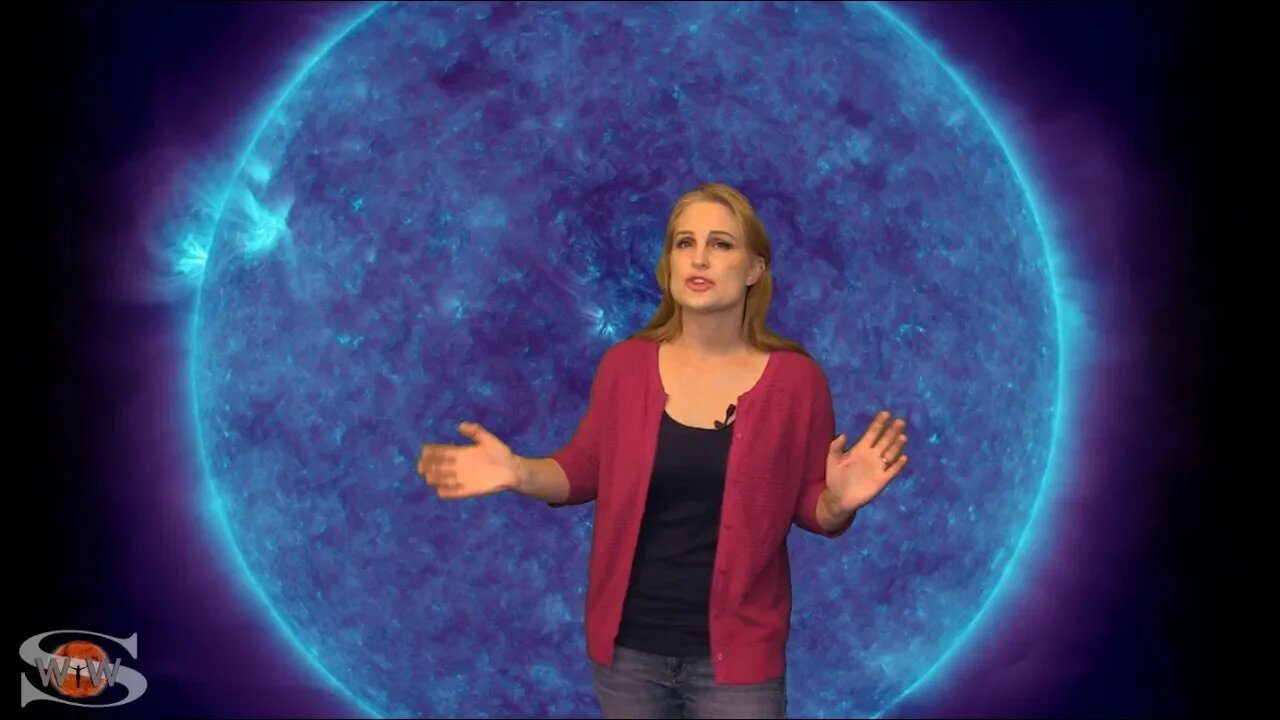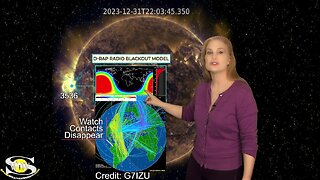Premium Only Content

Rise & Shine with Solar Flares: Solar Storm Forecast 05-24-2018
The Sun wakes up this week with several new bright regions that have rotated into Earth-view. The newest of these regions has been actively firing solar flares since it was on the Sun's backside. All this activity has boosted the solar flux so amateur radio operators and emergency responders are enjoying decent radio propagation. Meanwhile some pockets of fast wind continue to pummel Earth, keeping things at unsettled conditions. The wind isn't fast enough to bring us up to storm levels and bring aurora down to mid-latitudes, but it is enough to help improve GPS reception at low latitudes. Learn more about the new active regions, when the next solar storm is expected, and what else the Sun has in store for us this week.
For daily and often hourly updates (during active times) visit me on Twitter:
https://twitter.com/TamithaSkov
For a more in-depth look at the data and images highlighted in this video see these links below.
Solar Imaging and Analysis:
SDO: http://sdo.gsfc.nasa.gov/data/
Helioviewer: http://www.helioviewer.org/
Flare Analysis: http://www.lmsal.com/solarsoft/latest_events/
Computer Aided CME Tracking CACTUS: http://www.sidc.oma.be/cactus/out/latestCMEs.html
GOES Xray: http://www.swpc.noaa.gov/rt_plots/xray_1m.html
SOHO: http://sohodata.nascom.nasa.gov/
Stereo: http://stereo.gsfc.nasa.gov/
GONG magnetic field synoptic movie: https://gong.nso.edu/data/magmap/standard_movie.html
GONG magnetic field synoptic charts: http://gong.nso.edu/data/magmap/
LMSAL Heliophysics Events HEK http://www.lmsal.com/isolsearch
Solar Wind:
DISCOVR solar wind: http://www.swpc.noaa.gov/products/real-time-solar-wind
ACE Solar Wind: http://www.swpc.noaa.gov/products/ace-real-time-solar-wind
NASA ENLIL SPIRAL: https://iswa.gsfc.nasa.gov/IswaSystemWebApp/iSWACygnetStreamer?timestamp=2038-01-23+00%3A44%3A00&window=-1&cygnetId=261
NOAA ENLIL SPIRAL: http://www.swpc.noaa.gov/products/wsa-enlil-solar-wind-prediction
Magnetosphere, Ionosphere, Atmosphere:
GOES Magnetometer: http://www.swpc.noaa.gov/products/goes-magnetometer
Ionosphere D-Region Absorption (DRAP) model: http://www.swpc.noaa.gov/products/d-region-absorption-predictions-d-rap/
Auroral Oval Ovation Products: http://www.swpc.noaa.gov/products/aurora-30-minute-forecast
Global 3-hr Kp index: http://www.swpc.noaa.gov/products/planetary-k-index
Wing Kp index prediction: http://www.swpc.noaa.gov/products/wing-kp
USGS Ground Magnetometers: http://geomag.usgs.gov/realtime/
USGS Disturbance Storm-Time (Dst): http://geomag.usgs.gov/realtime/dst/
NAIRAS Radiation Storm Model: http://sol.spacenvironment.net/raps_ops/current_files/globeView.html
Multi-Purpose Space Environment Sites:
NOAA/SWPC: http://www.swpc.noaa.gov
SOLARHAM: http://www.solarham.net/index.htm
Spaceweather: http://spaceweather.com
iSWA: http://iswa.gsfc.nasa.gov/iswa/iSWA.html
Definition of Geomagnetic Storm, Radiation Storm, and Radio Blackout Levels:
http://www.swpc.noaa.gov/NOAAscales/
None of this would be possible without the hard work and dedication of those who have provided all of this data for public use.
Images c/o NASA/ESA/CSA (most notably the superb SDO, SOHO, ACE, STEREO, CCMC, JPL & DSN teams, amazing professionals, hobbyists, institutions, organizations, agencies and amateurs such as those at the USAF/HAARP, NICT, NOAA, USGS, Environment Canada, Natural Resources Canada, Intellicast, Catatania, rice.edu, wisc.edu, sonoma.edu ucalgary.ca, rssi.ru, ohio-state.edu, solen.info, and more. Thanks for making Space Weather part of our every day dialogue.
-
 12:43
12:43
Dr. Tamitha Skov
1 year ago $0.22 earnedBiggest X-Flare of Cycle 25 & Super Storm Launch | Space Weather Spotlight 02 January 2024
607 -
 44:44
44:44
Scammer Payback
9 hours agoCrazy Confrontation with Hacked Scammer Group
4.56K2 -
 1:09:00
1:09:00
vivafrei
4 hours agoKamala Harris Security Being "Pulled"? Kilmar Wants Trump Admin GAGGED! Fake News GALORE & MORE!
59.4K34 -
 1:33:32
1:33:32
The Quartering
6 hours agoContest Winners Picked, More Trans Attacks, SNL Collapsing, Raja Jackson STILL Not Arrested!
196K171 -
 1:19:44
1:19:44
Mark Kaye
6 hours ago🔴 Kamala FURIOUS Over Trump's Latest Move!
27.1K12 -
 2:52:14
2:52:14
LumpyPotatoX2
3 hours agoSkate: Early Access - #RumbleGaming
12K -
 21:14
21:14
Jasmin Laine
4 hours ago“Absolute Nonsense Policy”—CBC Guest DROPS Savage TRUTH! Poilievre LEAVES Reporters SPEECHLESS
18.4K14 -
 LIVE
LIVE
LFA TV
12 hours agoLFA TV ALL DAY STREAM - FRIDAY 8/29/25
962 watching -
 2:01:48
2:01:48
The Charlie Kirk Show
6 hours agoZero Percent Approval Democrats + Two Million Deportations | Bergquam, Sec. Noem, Bowyer | 8.29.2025
73.3K34 -
 1:52:52
1:52:52
Tucker Carlson
5 hours agoSSRIs and School Shootings, FDA Corruption, and Why Everyone on Anti-Depressants Is Totally Unhappy
60.9K89